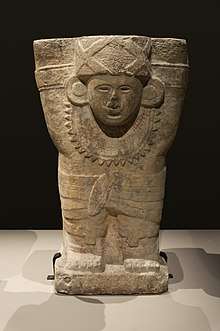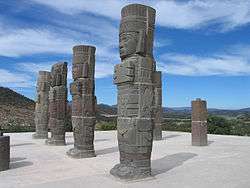Atlantean figures

Atlantean figures are carved stone support columns or pillars in the shape of fierce men in Pre-Columbian Mesoamerica. These figures are considered to be "massive statues of Toltec warriors".[1] They take their name from the European tradition of similar Atlas or Atalante figures in classical architecture, which was then revived in the Renaissance and especially popular in Baroque architecture. Atlantean here refers to the figures' supporting posture,[2] alluding to the load-bearing Titan Atlas,[3] not Atlantis.
Composition
Atlantean figures were made out of the available stone in the area, such as limestone, sandstone, or volcanic rock. They were carved by hand, presumably by multiple individuals at once. To carve them the individuals would have used stone tools, such as small chisels for fine sculpting, scrapers of various sizes to shape and add little details, and stone hammers to break the stones. Additional smaller and softer stones were used for smoothing. Creating these figures would have been very time-consuming, which is an indication that they served a purpose of some sort.
Sites
Potrero Nuevo
At Potrero Nuevo near San Lorenzo, there is an altar supported by two Atlantean figures. At the moment, it is believed to be the "oldest Mesoamerican example of the themes of atlantes holding up altars or ceilings"[4] The atlantes at this site are also unique compared to those found at other sites. The atlantes are not carved out roundly like they are at later sites. Instead they are carved into the background.
Chichen Itza
Chichen Itza is a site located on the northern centre of the Yucatan Peninsula and contains what is known as the Temple of Warriors. At the top of the temple, used as support for the roof, run columns of the carved warriors wearing a feathered headdress, a butterfly-shaped pectoral, and holding a dart thrower and darts.[1]
Tula
Tula has long been considered the capital for the Toltec people. At Tula one can find the Temple of Tlahuizcalpantecuhtli ('House of the Morning Star'), where there are four Atlantean figures standing over 4.6 metres (15 ft) tall. The figures here are depicted as wearing "stylized butterfly breastplates, sun-shaped shields on their backs, feathered headdresses and carry spear throwers and a supply of spears".[5] Modern archaeologists believe the importance of these statues in the mesoamerican context. Serving as pillars for a wooden or thatched tent, the mason masses depicted warriors, loyal to the Feathered Serpent, Quetzalcoatl, a god-king associated with Venus. The temple earned its name 'House of the Morning Star' from this association. [6]
Dating
The exact dates for when these figures were carved is unknown. However, rough estimates can be made by dating the sites. The construction of the Toltec empire has been dated to approximately A.D. 750, and Chichen Itza earlier to about A.D. 100-250.[7] These dates mark the earliest time that the figures could have been carved. Because of the similarity between the sites, it is likely that there are factors that influenced all the places. Therefore, it is also likely that the sculpting of these figures took place at a later date.
Significance
Political
There is indication that Atlantean figures "express the rise of new kind of military order and associated types of behaviour ".[8] Between A.D. 850 and A.D. 900, archaeological evidence in the form of an increased number of emblems found throughout Mesoamerica support the idea that there was a "shift in leadership from the traditional one of paramount lord supported by lesser nobles (reflected in the radial stable networks and outlying elite complexes) to one that recast these supporting groups in the form of military orders".[9] Mesoamerican Atlantean figures are seen to be the representation of this shift in political thinking.
Religious
Many researchers believe that the figures at Tula may represent the Toltec ruler Ce Acatl Quetzalcoatl. Ce Acatl Quetzalcoatl is believed to be "named after the fair-skinned god worshipped by many Mesoamerica cultures".[5] It is possible, therefore, that Atlantean figures in Mesoamerica also share not just political roots, but religious roots as well.
See also
| Wikimedia Commons has media related to Atlantes. |
References
- 1 2 Evans, Susan (2008). Ancient Mexico and Central America: Archaeology and Culture History. London: Thames & Hudson Ltd. p. 42.
- ↑ Adams, Richard E. W. (2005). Prehistoric Mesoamerica. U. of Oklahoma Press. p. 302. ISBN 978-0-8061-3702-5.
These are the famous Atlantean figures, so named from their posture of burden-bearing.
- ↑ "Atlantean". Oxford English Dictionary (3rd ed.). Oxford University Press. September 2005. (Subscription or UK public library membership required.) "Pertaining to, or having the supporting strength of, Atlas."
- ↑ Bernal, Ignacio (1969). The Olmec World. California: University of California Press. p. 58.
- 1 2 Ancient-Wisdom. "Tula". Retrieved 2 October 2011.
- ↑ "The Gigantic Atlantean Statues of the Toltecs - Mexico Unexplained". Mexico Unexplained. 2016-10-24. Retrieved 2017-09-29.
- ↑ Sacred Sited. "Chichen Itza". Retrieved 29 September 2011.
- ↑ Fash, William (2009). The Art of Urbanism: How Mesoamerican Kingdoms Represented Themselves in Architecture and Imagery. USA: Dumbarton Oak Publishing. p. 371.
- ↑ Fash, William (2009). The Art of Urbanism: How Mesoamerican Kingdoms Represented Themselves in Architecture and Imagery. USA: Dumbarton Oak Publishing. p. 374.
